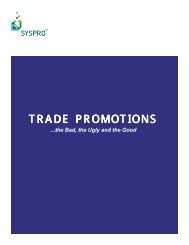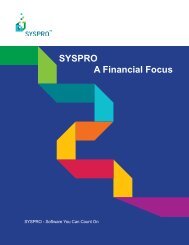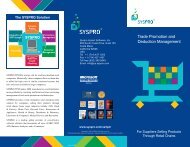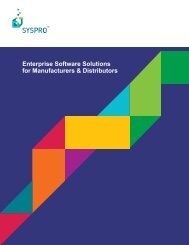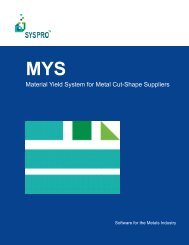Teach Yourself e.net - Syspro
Teach Yourself e.net - Syspro
Teach Yourself e.net - Syspro
You also want an ePaper? Increase the reach of your titles
YUMPU automatically turns print PDFs into web optimized ePapers that Google loves.
More Advanced Options<br />
XSLT Element<br />
xsl:element<br />
xsl:fallback<br />
xsl:for-each<br />
xsl:if<br />
xsl:import<br />
xsl:include<br />
xsl:key<br />
xsl:message<br />
xsl:namespace<br />
-alias<br />
xsl:number<br />
xsl:otherwise<br />
xsl:output<br />
xsl:param<br />
xsl:preserve -space<br />
xsl:processing<br />
-instruction<br />
xsl:sort<br />
xsl:strip-space<br />
Description<br />
Creates an element with the specified name in the output structure.<br />
Provides an alternative (or fallback) template when specific<br />
functionality is not supported by the XSLT processor being used for<br />
the transformation. This element provides greater flexibility during<br />
transformations as new XSLT versions come out in the future.<br />
Iterates over nodes in a selected node-set and applies a template<br />
repeatedly.<br />
This is used to wrap a template body that will be used only when the<br />
if statement test returns a true value.<br />
Allows an external XSLT style sheet to be imported into the current<br />
style sheet. The XSLT processor will give a lower precedence to<br />
imported templates as compared to templates in the original XSLT<br />
style sheet.<br />
Allows for the inclusion of another XSLT style sheet into the current<br />
style sheet. The XSLT processor gives the same precedence to the<br />
included templates as templates in the original XSLT style sheet.<br />
Declares a named key and is used in conjunction with the key()<br />
function in XPath expressions.<br />
This is used to output a text message and optionally terminate style<br />
sheet execution.<br />
This is used to map a prefix associated with a given namespace to<br />
another prefix. This can be useful when a style sheet generates<br />
another style sheet.<br />
Used to format a number before adding it to the result tree or to<br />
provide a sequential number to the current node.<br />
This is used with the xsl:choose and xsl:when elements to perform<br />
conditional testing. Similar to using default in a switch statement.<br />
Specifies options for use in serializing the result tree.<br />
This is used to declare a parameter with a local or global scope.<br />
Local parameters are scoped to the template in which they are<br />
declared.<br />
Preserves whitespace in a document. Works in conjunction with the<br />
xsl:strip-space element.<br />
Writes a processing instruction to the result tree.<br />
This is used with xsl:for-each or xsl:apply-templates to specify sort<br />
criteria for selected node lists.<br />
Causes whitespace to be stripped from a document. Works in<br />
conjunction with the xsl:preserve-space element.<br />
6–11




